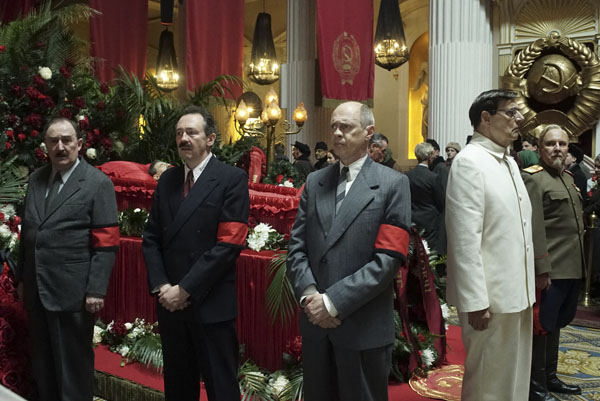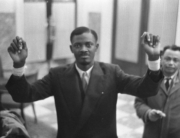
From left, Dermot Crowley, Paul Whitehouse, Steven Buscemi, and Jeffrey Tambor, and Paul Chahidi in The Death of Stalin (Nicola Dove/IFC Films)
![]() Armando Iannucci is perhaps best known for the sitcoms Veep and The Thick of It, both sharp satires of politicos and insiders in Washington and London, respectively. They are fun shows to watch as the characters we root for behave at their most craven and because Iannucci is a virtuoso of the cutting, multisyllabic crudity. While both are hilarious, they don’t cut deep. Not so The Death of Stalin.
Armando Iannucci is perhaps best known for the sitcoms Veep and The Thick of It, both sharp satires of politicos and insiders in Washington and London, respectively. They are fun shows to watch as the characters we root for behave at their most craven and because Iannucci is a virtuoso of the cutting, multisyllabic crudity. While both are hilarious, they don’t cut deep. Not so The Death of Stalin.
His new film makes use of these tropes, but this time he centers his characters on one of the most heinous monsters and oppressive regimes in history. This instantly gives heft to the work as the various ministers that control the Soviet Union under Stalin plot, scheme, worry, and sweat in the pettiest way possible while people are literally being shot in the background and herded into trucks headed to gulags. Iannucci has moved from farce to the blackest of comedies and succeeds brilliantly.
The plot begins in March 1953, the night right before Stalin’s death, as his closest advisors in the politburo, Nikita Khrushchev (Steve Buscemi), Georgy Malenkov (Jeffrey Tambor), Lavrentiy Beria (Simon Russell Beale), and Vyacheslav Molotov (Michael Palin), are laughing, drinking, and cozying up to Stalin (Adrian McLoughlin) while outside civilians are being rounded up after they are put on a hit list. So, just another night in Stalinist Russia. Except after the meeting disperses, the dictator ups and dies in his office.
Nobody finds out until the following morning because Stalin left strict instructions never to be disturbed. The moment the body hits the floor, the guards outside hear it and debate whether to check on him. If they are wrong, they may be killed. Of course, if they are right, they may become national heroes, and they will still be killed. So, they stay put.
Come morning, the truth is discovered, and the machinations begin. And the scheming does not end. At every point, someone is trying to enforce an agenda or move up the ladder, and everyone knows how to get under each other’s skin. The joy of the film is watching these skillful comic actors maneuver to one-up each other. Iannucci focuses on the mid-lever Khrushchev, who has the ideas but not the charisma to put them in place, and Beria, head of the secret police, who yearns for the love of the people. Their rivalry escalates until real damage is done when thousands die as they try to enter Moscow for the public viewing of Stalin because of the dueling orders between the two.
Iannucci has the benefit of crack comic performers that are up to the task of humanizing pretty terrible people. Buscemi’s Khrushchev is a consistently trying to rise above his position. His attempt to pull Molotov into his plot is stymied because the toilet he’s flushing to cover his conversation in Molotov’s bugged apartment “needs to fill up” before flushing again. So poor Khrushchev has to flush, talk, wait, flush, talk, wait, etc.
Meanwhile, Palin’s Molotov is the perfect apparatchik. His wife, whom he loved dearly, has been taken away and branded a traitor. Even after Stalin’s death, after everyone admits she was innocent. Bersa is simply terrifying as a sadist with tremendous power that he loves wielding—everyone tiptoes around him. Beale fills the character with such sadistic, sardonic joy he almost reaches the heights of Shakespearean villainy, which is understandable as Beale is one of Britain’s most noted classical actors.
As dictators and despots rise in this world, as democratic governments elect undemocratic leaders, Iannucci shows us our future by looking to the past. Simultaneously hilarious and terrifying, The Death of Stalin is a film of our times.






Leave A Comment